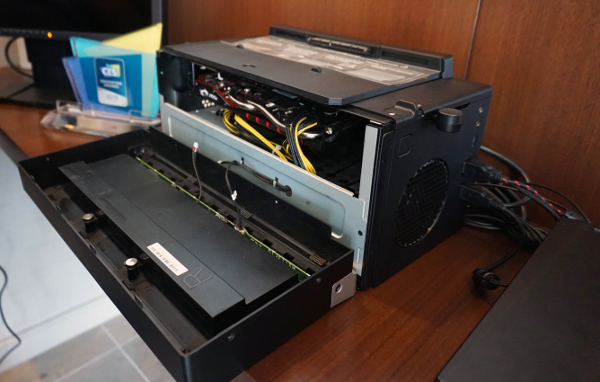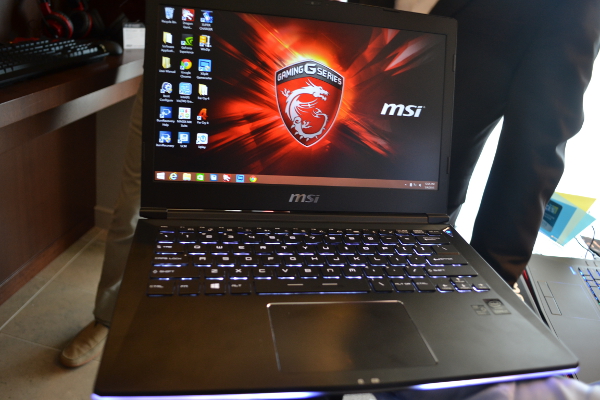MSI's External Gaming Dock And GS30 Shadow Gaming Notebook Offer Alternative PC Paradigm
My first impression of MSI's Gaming Dock, which was resting on a table with a gaming laptop perched atop it in the company's suite at CES, was that it was an ugly, bulky brick, and I instantly became concerned with how I was going to politely communicate that sentiment to the room full of MSI reps.
It didn't take long for me to change my opinion.
The Gaming Dock houses a full desktop GPU that can take over the notebook's graphics, and it does so via a proprietary PCIe x16 slot that's built into the rear hinge area of the GS30 Shadow. To take advantage of the Gaming Dock's GPU prowess, you simply pop the laptop into the dock and lock it in place with a lever. You can secure it further by flipping the lock tab.
Turn on the laptop, and you're ready to go. With an external monitor connected to the Gaming Dock, you have yourself a powerful gaming machine ready to roll.
There currently isn't any hot-swap capability, but MSI said that it has some custom software that protects the laptop from damage if (when) one carelessly yanks the GS30 Shadow off of the dock without first powering it down.
The Gaming Dock has plenty of its own ports to augment those of the GS30 Shadow, including at least three USB 3.0 ports, LAN jack, and headphone and mic jacks. Obviously, it has its own small PSU, as well. There's space for a 3.5-inch hard drive for extra storage, as well as integrated speakers.
The Gaming Dock is user-upgradable, as you can see, and it looks easy enough to swap cards in and out.
Get Tom's Hardware's best news and in-depth reviews, straight to your inbox.
None of the above negates the fact that the Gaming Dock is an ugly, blocky box. However, for some users, the box means freedom. For many of us, our computer setup consists of 1) a nice, powerful desktop, 2) a portable laptop of some kind, and 3) a smartphone. With the GS30 Shadow, you get that laptop, and when it's docked in the graphics-boosting Gaming Dock, you get a more powerful de facto desktop. Thus, you can remake your personal computing setup with just the GS30 Shadow, the Gaming Dock, and smartphone, with no desktop.
Granted, the GS30 Shadow is not a true desktop replacement, even with the external graphics juice. But it is a fairly powerful gaming laptop.
It has an Intel Core i7-4870HQ processor, Iris Pro Graphics 5200, 16 GB 1600 MHz DDR3 and 128 GB SSD RAID 0 storage. There's a gigabit Ethernet port with Intel 7260 (2x2) 802.11ac WiFi. It's a rather svelte machine for a gaming laptop, and it has a 13.3-inch 1920 x 1080 non-reflective display. Ports include two USB 3.0 ports, an SD card slot, HDMI, LAN, and headphone and mic jacks.
It's a petite laptop that's easily portable but packs a relatively big performance wallop, and when it's docked, it functions more or less as a desktop. Fundamentally, that changes how many PCs you may want to purchase. Why buy a laptop and a desktop when you can buy a laptop and a dock that's much smaller than a regular PC?
This setup is not for everyone — especially at a $2,000 price tag for the pair — but MSI believes there's a large-enough percentage of the enthusiast population who will see the GS30 Shadow and Gaming Dock as an ideal solution.
Follow Seth Colaner @SethColaner. Follow us @tomshardware, on Facebook and on Google+.
Seth Colaner previously served as News Director at Tom's Hardware. He covered technology news, focusing on keyboards, virtual reality, and wearables.
-
turkey3_scratch It's a unique idea, almost like adjoining laptop and desktop into one machine and then splitting them apart when you want to go mobile. I just think that for the price people already pay for laptops and with this on top they would not want to spend the money but rather just buy a gaming desktop or gaming laptop itself.Reply -
Gam3r01 Make this a bit more streamlined (smaller box, and make it seem more "meant to be" than just sitting on top), and cost slightly less and I would be interested in picking one up.Reply
I already like the idea, and think it could go places, just not for that pricepoint. -
JackNaylorPE I have two of these "in concept" on a shelf in my office...a 1996 Toshiba and a 2000 ish IBM. They came with a monitor stand and I used it with an external full size monitor, KB and mouse and it had built in 5.25 bays, SCSI, zip drives and everything else this has (and more) minus a "gaming specific GFX card". Ours were used primarily for AutoCAD.Reply
I hated when docking stations fell out of favor and bringing that lappie in meant reconnecting 5-6 cables (mouse, KB, ethernet, power, speakers, joystick) instead of "drop and latch". They were same footprint but about half as tall.
My guess is they took this form factor to allow the use of the laptop screen. I'd prefer the old form factor where the closed laptop slid into the docking station horizontally under the monitor stand. -
TechyInAZ I've had the same concept for a while now that laptops are getting more popular than desktops.Reply
However, I would prefer a thunderbolt connection so that more laptops could be compatible. -
knowom "does so via a proprietary PCIe x16 slot" probably simply a riser slot adapter like used for bitcoin mining or something similarReply -
C12Friedman Now I miss my old docking laptop but this does give me hope for the future of mobile computing. It's still a little pricy for me to jump at but I'm sure hoping this is the beginning of a trend and not just for laptops, as TechyInAZ points out, a Thunderbolt connection incorporated could really open the possibilitiesReply -
Nossy For $2000, I can get me a surface pro 3 (799USD) and a powerful pc rig with i5 4690k and GTX 970GTX (1200USD)Reply -
Vlad Razvan I've been waiting for something like this for years... but MSI's implementation has several major issues in my humble opinion:Reply
1. They should have used a cable to connect the eGPU to the laptop, instead of turning it into a dock, so one could use the laptop's display and keyboard to game while away from home.
2. Laptop is too small. 13" is portable, and I'm sure that's what they were going for, considering you can't comfortably use the laptops display while it's connected to the dock - but I would have prefered a slim 17 or 18" machine.
3. Dock is excessively bulky. I've seen mITX computers with dedicated GPUs smaller then that. Combined with the fact that you can't comfortably use the laptop's display with the eGPU, a mITX gaming sistem would make more sense, be cheaper and more upgradable.
I think the best idea so far is ASUS / Silverstone's external GPU via Thunderbolt - but that is also too big for an external enclosure. -
hoofhearted Isn't Alienware doing this with their new 13" model. Calling it the "Graphics Amplifier'.Reply




